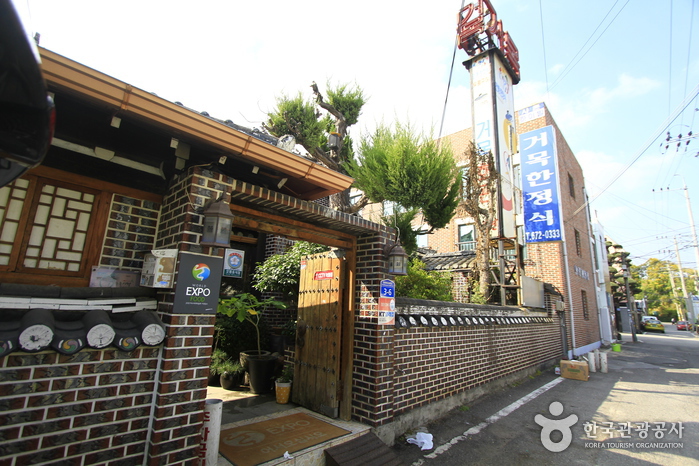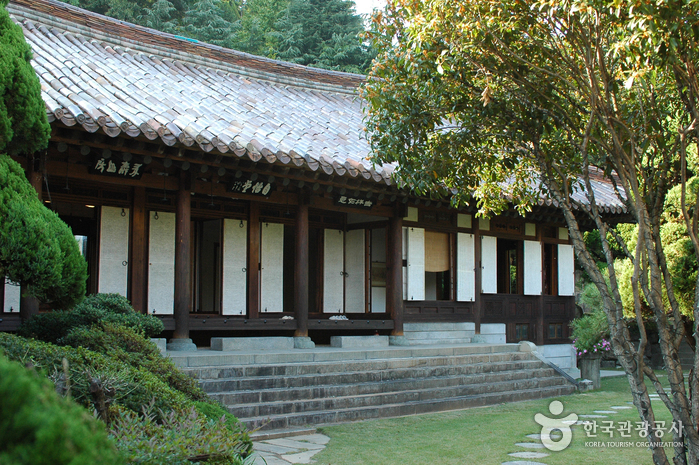Yangnim History & Culture Village (양림역사문화마을)
0m 5197 2023-11-28
7 Seoseopyeong-gil, Nam-gu, Gwangju
+82-62-676-4486
Yangnim History & Culture Village is located in the area where Western items and ideas first entered Gwangju over 100 years ago. As such, the neighborhood has a unique collection of Western architecture mixed with traditional hanok houses. There are also many houses of Christian missionaries, who facilitated the advancement of medicine and education in Gwangju. Some areas, such as Penguin Village, have been decorated with murals and outdoor exhibitions to promote art and tourism, helping the elderly locals to make a living.
Geomok Hanjeongsik (거목한정식)
167.3660664848048m 25936 2024-02-13
3-6 Cheonbyeonjwa-ro 364beon-gil, Nam-gu, Gwangju
+82-62-672-0333
Geomok Hanjeongsik is a restaurant that specializes in Namdo-style hanjeongsik (Korean table d'hote). Offering a singular menu item, hanjeongsik, guests select their preferred price range and the number of diners, and the dishes are prepared accordingly. A unique feature of this establishment is the seasonal variety of side dishes, ensuring a different culinary experience with each visit. Emphasizing health, the restaurant avoids strong-tasting chemical seasonings. Set in a converted hanok (traditional Korean house), Geomok Hanjeongsik provides a traditional atmosphere, enhancing the dining experience.
Palace Tourist Hotel (파레스 관광호텔)
300.5801518091474m 6884 2021-02-01
13, Jungang-ro 160beon-gil, Dong-gu, Gwangju
+82-62-222-2525
Palace Tourist Hotel is located only a six-minute walk from Geumnamro 4(sa)-ga Station on Gwangju Subway Line 1. Nearby attractions within walking distance include Gwangju Art Street and Yangdong Market.
Olive Young - Gwangju Hwanggeum Branch [Tax Refund Shop] (올리브영 광주황금)
333.54192212632546m 0 2024-04-16
1F, 31-12, Jungang-ro 160beon-gil, Dong-gu, Gwangju
-
Nature Republic - Gwangju Chungjang-ro Branch [Tax Refund Shop] (네이처리퍼블릭 광주충장로점)
387.59015733150767m 0 2024-04-16
80-8, Chungjang-ro, Dong-gu, Gwangju
-
Clubclio - Gwangju Chungjang-ro Club Branch [Tax Refund Shop] (클럽클리오 광주충장로클럽)
410.06818451682875m 0 2024-04-27
80-3, Chungjang-ro, Dong-gu, Gwangju
-
Ej Ost - Chungjang-ro (No. 2) Branch [Tax Refund Shop] (EJ OST 충장로2호)
410.06818451682875m 0 2024-04-17
80-3, Chungjang-ro, Dong-gu, Gwangju
-
MLB - Chungjang-ro Branch [Tax Refund Shop] (엠엘비 충장로점)
411.30585901307325m 0 2024-04-16
82-2, Chungjang-ro, Dong-gu, Gwangju
-
Chungjang-ro Street (충장로)
427.97221675836306m 27777 2023-11-17
Jungjang-ro, Dong-gu, Gwangju
+82-62-608-2221
Chungjang-ro Street is Gwangju’s major fashion district, comparable with Myeongdong Street of Seoul. The streets of Chungjang-ro are lined with shopping malls, clothing stores, restaurants, cafes, movie theaters and various other attractions, providing the ultimate experience of modern culture in Gwangju. It is the city's hub of fashion, both trendy and traditional, as well as venue for diverse performances.
House of Choi Seung-hyo (최승효가옥)
431.6737391530614m 13824 2023-03-08
29-4, Yangchon-gil, Nam-gu, Gwangju
+82-62-607-2332
The House of Choi Seung-hyo is a traditional residential building located on the southeastern slopes of Yangnimsan Mountain. The rectangular building is open to the east, has 8 kan (the space between two pillars) in the front and 4 kan to the sides, and is graced by a traditional hipped and gabled roof. Since the building was constructed in the 1920s, it offers a valuable glimpse into the architectural style of Korean houses at the end of the Japanese colonial period. Choi Sang-hyeon was an activist who offered his attic as a place of refuge for other activists.


![Olive Young - Gwangju Hwanggeum Branch [Tax Refund Shop] (올리브영 광주황금)](http://tong.visitkorea.or.kr/cms/resource/98/2886898_image2_1.jpg)
![Nature Republic - Gwangju Chungjang-ro Branch [Tax Refund Shop] (네이처리퍼블릭 광주충장로점)](http://tong.visitkorea.or.kr/cms/resource/03/2886903_image2_1.jpg)
![Clubclio - Gwangju Chungjang-ro Club Branch [Tax Refund Shop] (클럽클리오 광주충장로클럽)](http://tong.visitkorea.or.kr/cms/resource/92/2886892_image2_1.jpg)
![Ej Ost - Chungjang-ro (No. 2) Branch [Tax Refund Shop] (EJ OST 충장로2호)](http://tong.visitkorea.or.kr/cms/resource/96/2886896_image2_1.jpg)
![MLB - Chungjang-ro Branch [Tax Refund Shop] (엠엘비 충장로점)](http://tong.visitkorea.or.kr/cms/resource/00/2886900_image2_1.jpg)

 English
English
 한국어
한국어 日本語
日本語 中文(简体)
中文(简体) Deutsch
Deutsch Français
Français Español
Español Русский
Русский